Starting apple seeds indoors is simple and rewarding. You can grow healthy apple trees from tiny seeds.
This process offers a hands-on way to learn about gardening while preparing your seeds for outdoor planting. It’s fascinating to watch them sprout and grow, knowing you’ll have apple trees soon. Indoor germination protects young plants from harsh weather and pests.
This method gives your seeds a strong start, increasing their chances of successful growth outdoors. Whether you’re new to gardening or a seasoned pro, nurturing apple seeds indoors is an exciting journey. Ready to cultivate your own apple trees? Let’s explore the steps to get started and ensure your seeds thrive.
Benefits Of Starting Indoors
Starting apple seeds indoors offers many benefits for gardeners. Understanding how to start apple seeds indoors can lead to healthier plants and a more successful gardening experience. Let’s explore the advantages of this method.
Controlled Environment
One of the main benefits of starting apple seeds indoors is the controlled environment. By doing this, you can manage factors such as temperature, light, and humidity, which are crucial for seed germination and growth.
Here are some key advantages of a controlled environment:
- Temperature Regulation: Indoor settings allow you to maintain a consistent temperature, which is essential for seeds to sprout.
- Light Management: You can use grow lights to provide the right amount of light, even during short winter days.
- Humidity Control: Indoor environments help maintain proper humidity levels, preventing the seeds from drying out.
- Protection from Pests: Indoor environments shield your seeds from pests and diseases that can harm them.
Below is a table showing the ideal conditions for starting apple seeds indoors:
| Factor | Ideal Conditions |
|---|---|
| Temperature | 65-75°F (18-24°C) |
| Light | 12-16 hours of light per day |
| Humidity | 50-60% |
By maintaining these conditions, you can create an optimal environment for your seeds. This method is also useful for how to start carrot seeds indoors, how to start hollyhock seeds indoors, how to start lettuce seeds indoors, and how to start poppy seeds indoors.
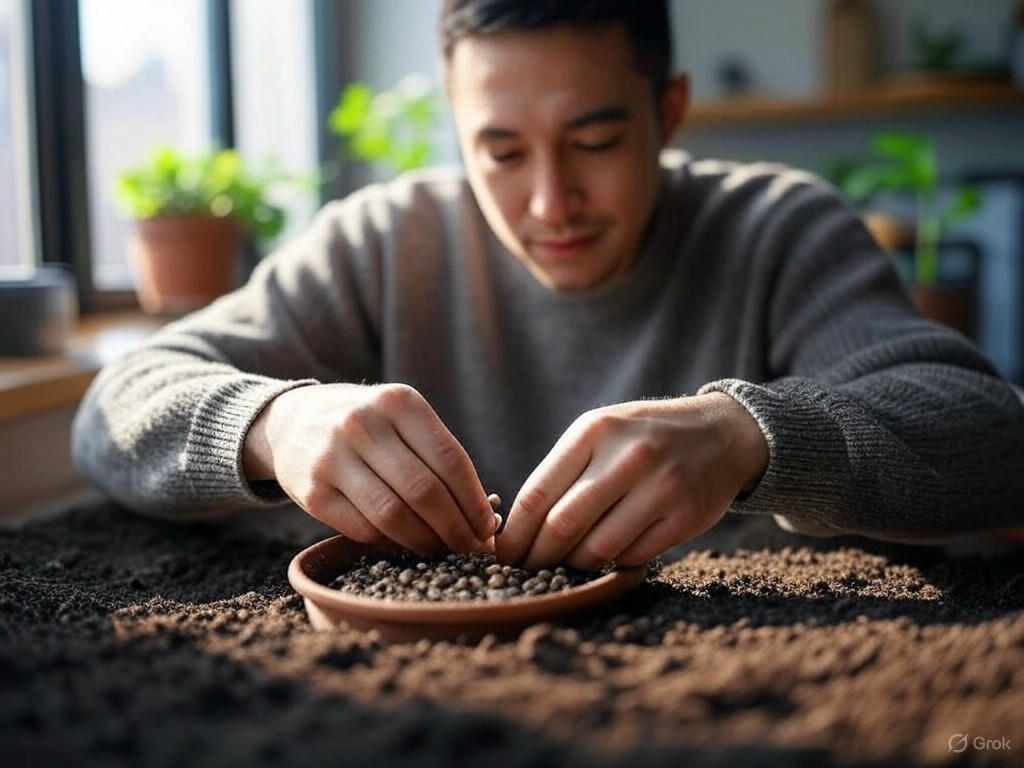
Table of Contents
Early Growth
Starting apple seeds indoors also promotes early growth. This gives your plants a head start before they are transplanted outside.
Here are some reasons why early growth is beneficial:
- Stronger Seedlings: Indoor growing allows you to nurture seedlings until they are strong enough to survive outside.
- Extended Growing Season: Starting seeds indoors extends the growing season, giving plants more time to mature.
- Better Root Development: Indoor conditions promote better root growth, leading to healthier plants.
- Less Competition: Indoor seedlings face less competition for resources than those sown directly outdoors.
Early growth is crucial for various plants, not just apple seeds. Knowing how to start carrot seeds indoors, how to start hollyhock seeds indoors, how to start lettuce seeds indoors, and how to start poppy seeds indoors can help you achieve similar benefits for these plants.
Starting apple seeds indoors provides a controlled environment and promotes early growth. This method ensures your plants are healthy and ready for outdoor planting.
Choosing The Right Seeds
Starting apple seeds indoors can be a rewarding experience. A crucial step in this process is choosing the right seeds. The quality of the seeds you select can significantly impact the growth and health of your apple trees. To help you make an informed decision, this section will cover the best sources for obtaining apple seeds and how to select the right variety for your needs.
Seed Sources
Finding reliable sources for apple seeds is essential. There are several options to consider:
- Local Nurseries: These are excellent places to find high-quality seeds. Nurseries often offer seeds suited to your local climate.
- Online Retailers: Many reputable online stores specialize in selling apple seeds. Look for reviews and ratings to ensure you are purchasing from a trusted source.
- Garden Clubs: Joining a garden club can provide access to seed exchanges. Members often share seeds from their own successful plants.
- Farmers’ Markets: Some farmers sell seeds from their own crops. This can be a great way to find seeds that are proven to grow well in your region.
Below is a table summarizing the pros and cons of each seed source:
| Seed Source | Pros | Cons |
|---|---|---|
| Local Nurseries | High quality, locally adapted | May have limited variety |
| Online Retailers | Wide selection, convenience | Shipping costs, varying quality |
| Garden Clubs | Community support, proven seeds | Limited availability |
| Farmers’ Markets | Locally adapted, organic options | Limited selection |
Variety Selection
Choosing the right variety is another important factor in how to start apple seeds indoors. Different apple varieties have unique characteristics and requirements. Consider the following:
- Climate Suitability: Ensure the variety you choose is suitable for your local climate. Some apples thrive in cooler regions, while others prefer warmer temperatures.
- Flavor Profile: Different varieties offer unique flavors. Decide whether you prefer sweet, tart, or a balance of both. Popular choices include Honeycrisp, Granny Smith, and Fuji.
- Growth Habit: Some apple trees grow larger than others. Dwarf varieties are ideal for small spaces or container gardening. Standard trees need more space but often produce larger yields.
- Pollination Needs: Many apple trees require cross-pollination. Planting multiple varieties that bloom simultaneously can improve fruit set. Consider varieties like Gala and Red Delicious that are good pollinators.
Here’s a quick reference table for some popular apple varieties:
| Variety | Climate Suitability | Flavor Profile | Growth Habit |
|---|---|---|---|
| Honeycrisp | Cool climates | Sweet and tart | Standard or dwarf |
| Granny Smith | Warm and cool climates | Tart | Standard |
| Fuji | Warm climates | Sweet | Standard |
By carefully selecting the right sources and varieties, you can ensure a successful start for your apple seeds indoors. This knowledge can also be applied to other seeds like how to start carrot seeds indoors, how to start hollyhock seeds indoors, how to start lettuce seeds indoors, and how to start poppy seeds indoors.
Preparing The Soil
Starting apple seeds indoors is an exciting project. It allows you to nurture a future apple tree right from the comfort of your home. A critical step in this process is preparing the soil. The right soil will ensure that your apple seeds get the best start possible. Let’s dive into the details.
Soil Types
Choosing the correct soil type is crucial for the healthy growth of your apple seeds. Apple seeds require well-draining soil. Here are some common soil types you might consider:
- Loamy Soil: This soil type is a mix of sand, silt, and clay. It offers good drainage and moisture retention.
- Sandy Soil: This type drains well but does not hold nutrients as effectively. You might need to supplement it with organic matter.
- Clay Soil: It retains water and nutrients well but can be too dense for seeds. Mixing it with sand or organic matter can improve its texture.
For starting apple seeds indoors, loamy soil is typically the best choice. It balances drainage and nutrient retention well. If you’re also interested in how to start carrot seeds indoors or how to start lettuce seeds indoors, loamy soil works well for those too.
If you prefer to create your own soil mix, here’s a simple recipe:
| Ingredient | Proportion |
|---|---|
| Compost | 1 part |
| Peat Moss | 1 part |
| Perlite | 1 part |
This mix ensures good drainage and provides the necessary nutrients for your apple seeds. You can use this mix for other seeds too, such as how to start poppy seeds indoors or how to start hollyhock seeds indoors.
Nutrient Requirements
Apple seeds need specific nutrients to grow into healthy seedlings. These nutrients should be present in the soil:
- Nitrogen (N): Essential for leaf growth and overall plant health.
- Phosphorus (P): Important for root development and energy transfer.
- Potassium (K): Helps with disease resistance and water regulation.
In addition to these macronutrients, apple seeds also benefit from micronutrients such as calcium, magnesium, and iron. These nutrients support various physiological functions in the plant.
To ensure your soil has these nutrients, you can use a balanced fertilizer. Look for a fertilizer with an N-P-K ratio of 10-10-10. This means it has equal parts nitrogen, phosphorus, and potassium.
If you’re interested in how to start carrot seeds indoors or how to start lettuce seeds indoors, these plants also benefit from a balanced fertilizer. Always follow the instructions on the fertilizer package to avoid over-fertilizing, which can harm the seedlings.
Organic matter is another excellent way to add nutrients to your soil. Compost and well-rotted manure are rich in essential nutrients. They also improve soil structure and water retention.
Whether you are learning how to start apple seeds indoors or how to start hollyhock seeds indoors, proper soil preparation is key to success. Happy planting!

Planting The Seeds
Starting apple seeds indoors can be a rewarding experience. It allows you to witness the entire growth process from seed to sapling. To achieve the best results, follow these steps carefully. One of the most crucial stages is planting the seeds. This section will guide you through the essential aspects of planting depth and spacing tips to ensure your apple seeds have the best start.
Planting Depth
Planting the seeds at the right depth is vital for their growth. If the seeds are too shallow, they may dry out. If too deep, they might not sprout. Here’s a simple guide to get it right:
- Depth: Plant apple seeds about 1/2 inch deep. This depth ensures they are covered enough to retain moisture but not too deep to hinder their sprouting.
- Soil Preparation: Use a well-draining potting mix. A mix of peat moss, perlite, and compost works well. This blend provides the necessary nutrients and drainage.
- Watering: Keep the soil moist but not waterlogged. Water the soil lightly after planting the seeds.
Here’s a quick reference table to help you remember:
| Seed Type | Planting Depth |
|---|---|
| Apple | 1/2 inch |
| Carrot | 1/4 inch |
| Hollyhock | 1/8 inch |
| Lettuce | 1/8 inch |
| Poppy | Surface sow |
Spacing Tips
Proper spacing is just as important as planting depth. It ensures each seedling has enough room to grow. Crowded seedlings can become weak and susceptible to diseases. Here are some tips:
- Seed Spacing: Space apple seeds at least 1-2 inches apart. This gives them room to grow without competing for nutrients.
- Thinning: Once the seedlings sprout and grow a few inches tall, thin them out. Keep the strongest seedlings about 4-6 inches apart.
- Container Size: Use a container that is at least 6 inches deep and wide. This provides enough space for root development.
Here’s a spacing guide for different seeds:
| Seed Type | Initial Spacing | Thinning Spacing |
|---|---|---|
| Apple | 1-2 inches | 4-6 inches |
| Carrot | 1/2 inch | 2-3 inches |
| Hollyhock | 1 inch | 12-18 inches |
| Lettuce | 1 inch | 6-12 inches |
| Poppy | Surface sow | 6 inches |
By following these tips, you can give your apple seeds the best start indoors. Proper planting depth and spacing will ensure healthy growth. Whether you’re learning how to start apple seeds indoors, how to start carrot seeds indoors, or any other seeds, these principles remain the same. Happy planting!
Watering Techniques
Starting apple seeds indoors requires careful attention to various factors, one of the most crucial being watering techniques. Proper watering ensures that your seeds germinate successfully and grow into healthy seedlings. Understanding the right frequency and quality of water can make a significant difference in the growth of your apple seeds.
Frequency
Watering your apple seeds at the right frequency is essential for their development. Over-watering can lead to root rot, while under-watering can cause the seeds to dry out and fail to germinate. Here are some guidelines to help you:
- Initial Watering: When you first plant your apple seeds, give them a thorough watering to ensure the soil is evenly moist. This helps to settle the soil around the seeds.
- Daily Checks: Check the soil moisture daily. Use your finger to test the top inch of soil. If it feels dry, it’s time to water.
- Consistent Moisture: Keep the soil consistently moist but not waterlogged. This can be achieved by watering every two to three days, depending on the humidity and temperature of your indoor environment.
- Avoid Over-watering: Be cautious not to over-water. Excess water can suffocate the seeds and prevent oxygen from reaching them.
Below is a table summarizing the frequency of watering for various seeds:
| Seed Type | Watering Frequency |
|---|---|
| Apple Seeds | Every 2-3 days |
| Carrot Seeds | Every 2-3 days |
| Hollyhock Seeds | Every 4-5 days |
| Lettuce Seeds | Every 1-2 days |
| Poppy Seeds | Every 3-4 days |
Water Quality
The quality of water you use is equally important as the frequency. Poor water quality can introduce harmful elements into the soil, affecting the growth of your apple seeds. Here are some tips to ensure you use the best water for your seeds:
- Clean Water: Use clean, fresh water free from contaminants. Tap water is generally acceptable, but if it’s heavily chlorinated, consider using filtered water.
- Room Temperature: Water should be at room temperature. Extremely cold or hot water can shock the seeds and hinder their growth.
- pH Levels: Ideal water pH for apple seeds is between 6.0 and 7.0. Use a pH meter to check your water and adjust if necessary.
- Avoid Hard Water: Hard water contains high levels of minerals which can accumulate in the soil. This can affect the nutrient balance and seed growth.
Using the right water quality ensures your seeds have the best environment to thrive. Whether you’re learning how to start apple seeds indoors or exploring how to start carrot seeds indoors, how to start hollyhock seeds indoors, how to start lettuce seeds indoors, or how to start poppy seeds indoors, these principles remain consistent across different types of seeds.

Providing Adequate Light
Starting apple seeds indoors can be a rewarding endeavor. One critical factor for success is providing adequate light. Light is essential for the growth and development of your apple seedlings. Without it, seedlings become weak and leggy. There are two main types of light you can use: natural and artificial. Knowing how to provide the right type of light can make a big difference in the health of your seedlings.
Natural Vs. Artificial
When learning how to start apple seeds indoors, understanding the difference between natural and artificial light is crucial.
Natural light is the best option if you have a sunny window. South-facing windows provide the most light. East and west-facing windows can also work. Here are some tips for maximizing natural light:
- Place seedlings on a windowsill that gets at least 6 hours of sunlight daily.
- Rotate the pots every few days to ensure even light exposure.
- Use reflective surfaces, like white walls, to increase light intensity.
While natural light is ideal, it is not always sufficient. In many cases, artificial light is necessary. Fluorescent and LED grow lights are popular choices. They are energy-efficient and can be used to supplement or replace natural light. Here are some tips for using artificial light:
- Place the light source 2-4 inches above the seedlings.
- Keep the lights on for 12-16 hours a day.
- Use a timer to maintain a consistent light schedule.
Both natural and artificial light have their advantages. Your choice depends on your specific needs and growing conditions.
Light Duration
The duration of light exposure is another important factor in how to start apple seeds indoors. Seedlings need a certain amount of light each day to thrive. Here’s a simple guide to light duration:
| Plant Type | Hours of Light Needed |
|---|---|
| Apple Seeds | 12-16 hours |
| Carrot Seeds | 12-14 hours |
| Hollyhock Seeds | 10-12 hours |
| Lettuce Seeds | 14-16 hours |
| Poppy Seeds | 12-14 hours |
Using a timer can help you manage light duration effectively. Consistent light exposure is key to preventing issues like leggy seedlings. Adjust the light duration based on the growth stage of your plants. Younger seedlings often require more light.
Remember, too much light can be as harmful as too little. Ensure your seedlings get some dark hours to rest. This balance is important for healthy growth.
Understanding light duration is essential not only for how to start apple seeds indoors but also for other plants like carrots, hollyhocks, lettuce, and poppies. Tailoring light conditions to each plant’s needs ensures robust and healthy seedlings.
Transplanting Outdoors
Starting apple seeds indoors is a rewarding endeavor that sets the stage for a thriving garden. Once your seedlings have grown strong, it’s time to transplant them outdoors. This crucial phase ensures your apple trees adapt well to their new environment. Let’s explore the best practices for transplanting your indoor-grown apple seedlings into the great outdoors.
Timing
Transplanting apple seedlings at the right time is essential for their survival and growth. Timing is everything in gardening. For apple seeds, the best time to transplant outdoors is typically during the early spring. This period allows seedlings to establish roots before the heat of summer.
Consider the following factors when choosing the right timing:
- Last Frost Date: Ensure that the last frost has passed. Apple seedlings are sensitive to frost and cold weather.
- Soil Temperature: The soil should be warm enough to support root development. Aim for a soil temperature of at least 60°F (15°C).
- Weather Conditions: Choose a day with mild weather. Avoid extremely windy or rainy days to prevent stress on the seedlings.
By paying attention to these factors, you will create the best conditions for your apple seedlings to thrive outdoors.
Acclimatization
Acclimatization is the process of gradually adapting your apple seedlings to outdoor conditions. This step is crucial to prevent shock and ensure healthy growth.
Follow these steps for successful acclimatization:
- Gradual Exposure: Start by placing your seedlings outside for a few hours each day. Increase the time spent outdoors gradually over a week.
- Shade Protection: Initially, provide some shade to protect the seedlings from direct sunlight. Gradually reduce the shade as the seedlings get accustomed to the sun.
- Wind Protection: Shield your seedlings from strong winds during their acclimatization period. Use windbreaks or place them in a sheltered area.
- Watering: Keep the soil consistently moist but not waterlogged. Proper hydration is key during this transition.
Creating a table can help monitor your acclimatization schedule:
| Day | Outdoor Time | Shade Protection | Wind Protection |
|---|---|---|---|
| 1 | 2 hours | Full shade | Sheltered |
| 2 | 4 hours | Partial shade | Sheltered |
| 3 | 6 hours | Partial shade | Moderate wind protection |
| 4 | 8 hours | Minimal shade | Moderate wind protection |
| 5 | 10 hours | No shade | Minimal wind protection |
Using these methods, your apple seedlings will be well-prepared for outdoor growth.

Frequently Asked Questions
How To Germinate Apple Seeds At Home?
Soak apple seeds in water for 24 hours. Place seeds in a damp paper towel inside a plastic bag. Refrigerate for 6 weeks. Plant seeds in pots with soil. Water regularly and ensure they get sunlight.
Should Apple Seeds Be Soaked Before Planting?
No, apple seeds should not be soaked before planting. Instead, stratify them in the refrigerator for 6-8 weeks.
Can You Grow Apples From The Seeds Inside?
Yes, you can grow apples from the seeds inside. However, the resulting apple trees may not produce the same quality of apples. For best results, consider grafting.
How Long Will It Take To Grow An Apple Tree From A Seed?
It takes 7-10 years to grow an apple tree from a seed. Patience is key for successful growth.
What Materials Do I Need To Start Apple Seeds Indoors?
You need apple seeds, small pots, potting soil, and water.
How Should I Prepare Apple Seeds For Planting?
Dry seeds for a few days. Then, soak them in water for 24 hours.
What Is The Best Soil For Apple Seeds?
Use well-draining potting soil. It keeps seeds healthy and prevents rot.
Conclusion
Growing apple seeds indoors can be a fun project. It requires patience and care. Start with good seeds. Prepare the soil well. Water them regularly, but not too much. Give them enough light. Soon, you will see small sprouts. Enjoy watching them grow.
This process is rewarding and educational. Anyone can do it with basic effort. Good luck with your apple seedlings!



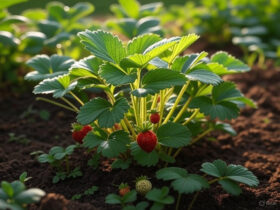



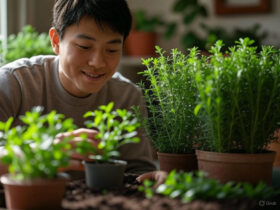
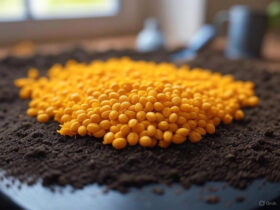
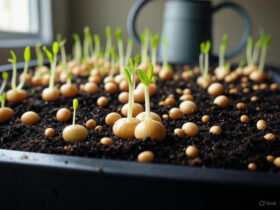

Leave a Reply